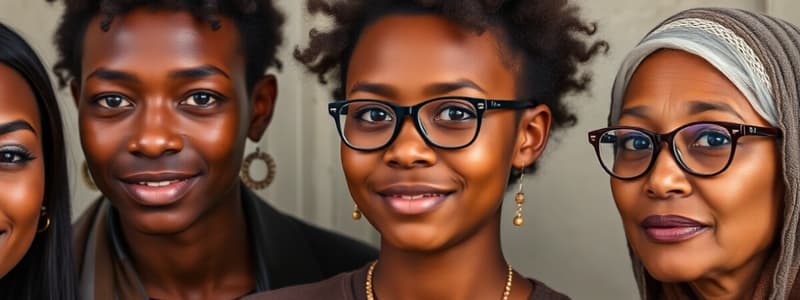Podcast
Questions and Answers
What is the goal of the Truth and Reconciliation Commission (TRC)?
What is the goal of the Truth and Reconciliation Commission (TRC)?
To bring closure to the legacy of Indian residential schools and to renew the relationships among people who attended these schools, their families, and all Canadians.
Which of the following is NOT a goal of the Truth and Reconciliation Commission (TRC)?
Which of the following is NOT a goal of the Truth and Reconciliation Commission (TRC)?
- To establish a system that ensures all Indigenous children living in Canada are provided culturally relevant education. (correct)
- To provide support for healing and to establish a system that ensures all Indigenous children obtain a top-notch culturally relevant education.
- To renew relationships among people who attended the schools, their families, and all Canadians.
- To bring closure to the legacy of Indian residential schools.
The ______ school system in Canada is widely considered a form of cultural ______.
The ______ school system in Canada is widely considered a form of cultural ______.
Explain how Robyn Montour's family is different from most Canadian families.
Explain how Robyn Montour's family is different from most Canadian families.
What is the difference between the terms "Indigenous" and "Aboriginal"?
What is the difference between the terms "Indigenous" and "Aboriginal"?
What are the four main responses to minority status integration?
What are the four main responses to minority status integration?
The term "race" is used in the social sciences as a social mechanism.
The term "race" is used in the social sciences as a social mechanism.
Define the term "ethnicity".
Define the term "ethnicity".
What is the difference between prejudice and discrimination?
What is the difference between prejudice and discrimination?
What are the different acculturation policies used by dominant groups?
What are the different acculturation policies used by dominant groups?
What are the two dimensions of acculturation strategies?
What are the two dimensions of acculturation strategies?
What is the purpose of the Truth and Reconciliation Commission (TRC)?
What is the purpose of the Truth and Reconciliation Commission (TRC)?
What is the most shameful thing that can happen to a culture?
What is the most shameful thing that can happen to a culture?
What is a stereotype?
What is a stereotype?
What is a major disadvantage faced by immigrants when they arrive in a new country?
What is a major disadvantage faced by immigrants when they arrive in a new country?
It is a myth that different cultures are just one human race.
It is a myth that different cultures are just one human race.
What is "race"?
What is "race"?
Flashcards
What is 'race'?
What is 'race'?
A social concept invented in the 18th century to categorize populations brought together in colonial America, such as English settlers, indigenous peoples, and enslaved people from Africa. Physical variations in humans have no inherent social meaning.
Ethnicity
Ethnicity
A term used to specify a group of people who share a common cultural heritage. Examples include Chinese, Italian, Haitian, and Ukrainian.
What was the residential school system?
What was the residential school system?
A government-run system of schools in Canada that aimed to assimilate Indigenous children into mainstream Canadian society. This system resulted in significant cultural disruption and abuse.
What was the 'Sixties Scoop'?
What was the 'Sixties Scoop'?
Signup and view all the flashcards
What is the ecological model?
What is the ecological model?
Signup and view all the flashcards
What is the macrosystem in the ecological model?
What is the macrosystem in the ecological model?
Signup and view all the flashcards
Stereotype
Stereotype
Signup and view all the flashcards
Discrimination
Discrimination
Signup and view all the flashcards
Direct Discrimination
Direct Discrimination
Signup and view all the flashcards
Indirect Discrimination
Indirect Discrimination
Signup and view all the flashcards
Acculturation
Acculturation
Signup and view all the flashcards
Integration
Integration
Signup and view all the flashcards
Assimilation
Assimilation
Signup and view all the flashcards
Separation
Separation
Signup and view all the flashcards
Marginalization
Marginalization
Signup and view all the flashcards
Passing
Passing
Signup and view all the flashcards
Multiculturalism
Multiculturalism
Signup and view all the flashcards
Melting Pot
Melting Pot
Signup and view all the flashcards
Segregation
Segregation
Signup and view all the flashcards
Exclusion
Exclusion
Signup and view all the flashcards
Indigenous
Indigenous
Signup and view all the flashcards
Aboriginal
Aboriginal
Signup and view all the flashcards
Visible minority
Visible minority
Signup and view all the flashcards
Minority group
Minority group
Signup and view all the flashcards
Dominant group
Dominant group
Signup and view all the flashcards
Social capital
Social capital
Signup and view all the flashcards
Passing
Passing
Signup and view all the flashcards
Ethnic identity
Ethnic identity
Signup and view all the flashcards
Ethnic community
Ethnic community
Signup and view all the flashcards
Linguistic competence
Linguistic competence
Signup and view all the flashcards
Cultural competence
Cultural competence
Signup and view all the flashcards
Study Notes
Ethnicity and Race
- Ethnicity is a system of classifying people based on shared cultural heritage
- Race is a system of classifying people based on physical characteristics, such as skin color
- The concept of race has social and political implications, not biological ones
- The idea of race as a social construct was socially developed during the 18th century
- Today, scholars and experts in many fields acknowledge that human populations are not in separate, distinct divisions although physical differences exist
- The concept of race remains present in many parts of the world and in social institutions, despite knowledge that humans share similar genetic characteristics
Studying That Suits You
Use AI to generate personalized quizzes and flashcards to suit your learning preferences.




